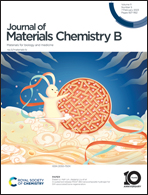A multiphoton transition activated iron based metal organic framework for synergistic therapy of photodynamic therapy/chemodynamic therapy/chemotherapy for orthotopic gliomas†
Abstract
Although photodynamic therapy (PDT) has exhibited good potential in therapy of gliomas, the limited penetration depth of light and the obstacle of the blood–brain barrier (BBB) lead to unsatisfactory treatment effects. Herein, a multifunctional nanodrug (UMD) was constructed with up-conversion nanoparticles (NaGdF4:Yb,Tm@NaYF4:Yb,Nd@NaYF4, UCNPs) as the core, the photosensitizer NH2-MIL-53 (Fe) as the shell and a carrier for loading chemotherapy drug doxorubicin hydrochloride (Dox) for synergistic therapy of gliomas. Lactoferrin (LF) was finally modified on the surface of the UMD to endow it with the ability to traverse the BBB and target cells (UMDL). The UCNP core can convert 808 nm near-infrared (NIR) light to ultraviolet light (UV light) for exciting NH2-MIL-53 (Fe), achieving NIR-mediated PDT. In addition, Fe3+ on the surface of the NH2-MIL-53 (Fe) shell could be reduced to Fe2+ in a tumor microenvironment (TME), and then reacted with over-expressed H2O2 in the TME to generate hydroxyl radicals (˙OH) for chemodynamic therapy (CDT). The Dox drug could be released in response to acidic conditions in the TME, inhibiting the growth of gliomas with low side effects. The synergistic effect of PDT/CDT/chemotherapy leads to effective suppression of orthotopic gliomas.



 Please wait while we load your content...
Please wait while we load your content...